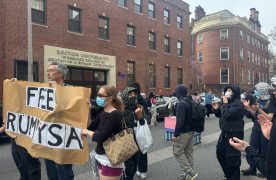The Supreme Court voted 6-2 on June 29 on the case Students For Fair Admissions v. Harvard College in a decision which determined that affirmative action in higher education violated the Equal Protections Clause of the Fourteenth Amendment, reversing nearly half a century of legal precedent.
In an ironic twist that would leave Abraham Lincoln rolling in his grave, an amendment that was written to protect newly-freed slaves at the end of the Civil War from legal discrimination has been weaponized against their own descendants and other marginalized communities.

For all those besides the strictest of Constitutional originalists, the crux of the question vis-à-vis the value of affirmative action comes down to this: 247 years into the founding of our Republic, has America finally become a place where all people are not only created — but treated — equally regardless of race, color, or creed?
Well, even a cursory overview of some basic statistics related to racial disparities throughout the nation makes it clear the answer to that question is a resounding no. From income to unemployment, sentence lengths to incarceration rates, and education levels to maternal mortality, people of color perform more poorly compared to their white fellow citizens in almost every category.
If that’s the case then, how was this allowed to happen? More importantly, what can universities across the country, shining beacons of progress as they tout themselves to be, do in order to try and minimize the effects this decision will have on communities already victimized by systemic racism?
Within living memory, the Supreme Court has historically been a progressive force in the body politic, responsible for many of the advancements in Civil Rights gained by oppressed races, genders and sexualities throughout the mid-20th century.
However, ever since the appointment of ultraconservative William Rehnquist under the Reagan administration in 1986, the Court has been on marked lurch toward the right, a process rapidly accelerated by the appointment of three new conservative justices under Trump — Neil Gorsuch, Brett Kavanaugh and Amy Coney Barrett — the most appointments made under a single president since Reagan himself.
Since conservatives consolidate their power over the court under Trump, the SCOTUS has become increasingly infamous for handing down conservative decision after conservative decision, most notably the overturning of Roe V. Wade last year in yet another reversal of one of the midcentury court’s most important progressive rulings.
The fact that Trump’s court packing has so quickly been able to revert so much of more than 70 years of progress, much of which was only made possible by Franklin D. Roosevelt’s court packing in turn, has caused increasing skepticism toward the place the SCOTUS holds in our democracy.
If one does an assessment of high courts in other countries, in fact, the American Supreme Court is an international outlier. No other place in the world allows such a small handful of appointed officials serving lifelong terms to unilaterally strike down legislation drafted by democratically-elected representatives.
Over the past few years, as this excessive authority has been more frequently used to take rights away than to grant them, proposed reforms include: increasing the number of justice from nine, imposing term limits on justices or creating a code of conduct or some other system of accountability judges must abide by.
However, with the current state of partisan polarization and the lower case “c” conservative nature of the United States Constitution, any structural changes to the Supreme Court in the near future is exceedingly unlikely.
What then can Boston universities and other institutions of higher education throughout the country do if not to fight, then work around, this decision?
One method would be to eliminate or decrease the number of legacy admissions, who are overwhelmingly white, that are accepted into universities, therefore making more space for students who earned their spots through merit alone.
Another would be to encourage students from marginalized groups to apply more by increasing outreach in communities where said groups are concentrated. “Outreach” looks like many things including offering programs and courses to high school students, conducting community service, targeting marginalized groups through social media and many other forms.
The simplest work around to the Students For Fair Admissions v. Harvard’s decision would include optional questions in which students can talk about their relationship to race other than outright asking “what is your race” above a dropdown menu.
An easy example of said questions would be: “Duke values all kinds of differences … tell us anyways in which you’re different and how that has affected you,” Sarah Lawrence College even included the question. “…describe how you believe your goals for a college education might be impacted, influenced or affected by the Court’s decision.”
Finally, history has shown us that when states have banned affirmative action, unsurprisingly the number of students attending institutions of higher education from groups affirmative action was intended to support has gone down.
This means that Boston University, already a predominantly-white institution, will most likely only become more so over the next few years. The administration and student body must take every measure necessary to ensure that minority students continue to feel welcomed and valued in the BU community as we ride out the impact of this unprecedented defeat for marginalized students everywhere.
This editorial was written by Opinion Co-Editor Nathan Metcalf














